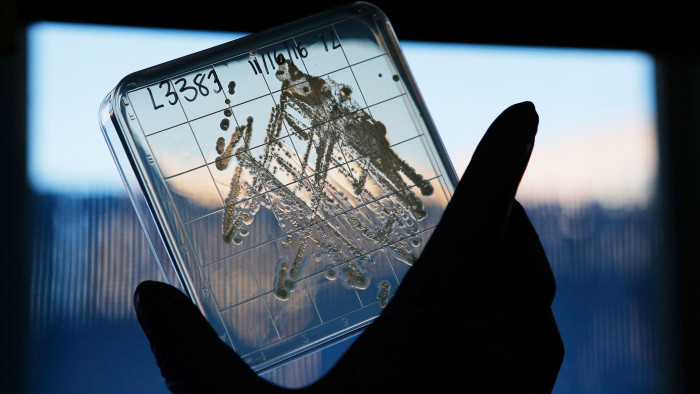AI offers new hope in defeating superbugs

Roula Khalaf, Editor of the FT, selects her favourite stories in this weekly newsletter.
Hal, the artificial intelligence of 2001: A Space Odyssey, was no friend to the crew of Discovery One. In the course of its mission, the malicious machine attempted to kill everyone on the spaceship. MIT researchers hope that halicin, its namesake, will do the opposite. In lab tests the antibiotic, discovered by an AI program, was able to kill 35 powerful bacteria, some considered untreatable with current antibiotics.
The discovery offers hope in the face of an impending disaster. Last year, the World Health Organization listed antimicrobial resistance as one of the top ten threats to global health, alongside flu pandemics, HIV and climate change. But new technologies are only a part of a global overhaul needed to avoid the situation worsening.
The MIT algorithm discovered halicin by studying the structure of various chemicals and predicting how effective each molecule might be against specific bacteria. Its knowledge of existing antibiotics helped it avoid creating a medicine similar to other compounds that may be ineffective because diseases have become resistant to them. The news follows last year’s announcement by 10 large pharmaceutical companies that they would be pooling data for an AI-based search for new drugs, as the medical industry increasingly recognises the value of machine intelligence.
Rising antibiotic resistance has several sources. One is doctors prescribing drugs without being able to test whether patients are suffering from bacteria (which they can beat) or other pathogens (which they cannot). This is compounded when sufferers stop their courses of treatment early because symptoms cease. Industry is also responsible, due to the continued use of antibiotic-enriched feed around the world to boost livestock growth.
In the US alone, the Centers for Disease Control and Prevention estimates 35,000 people already die annually from antibiotic resistant bacteria. The effects are not restricted to the direct death toll. The heightened risk can make medical professionals less willing to carry out important surgeries, while longer hospital stays are a drain on resources.
Market forces have stymied the creation of more potent drugs. For many smaller companies, taking a new chemical from early clinical tests to a national or global rollout is prohibitively expensive. Even bigger drugmakers have weaker incentives to create new antibiotics — normally prescribed for a week at most — rather than developing drugs that are used for longer periods. Antibiotics may also be kept back for emergency use to stop microbes becoming resistant.
Halicin suggests that automation could solve part of the problem by reducing the costs of carrying out clinical trials or finding new compounds. But the broader drug discovery market still needs a big shake-up. One proposal last year, from UK health secretary Matt Hancock but not yet acted on, was for the National Health Service to pay pharmaceutical companies upfront based on the value of the drug rather than the quantity sold. Applying that sort of thinking worldwide may be needed to ensure that AI-based antibiotic research gains wider adoption.
Yet even if the pharma industry gets sufficient incentives to push new antibiotics through the costly development process, more policy work is necessary. Powerful new drugs must only be used when really needed. Better education is required to understand how resistance develops and how to prevent it. Stronger regulations are also needed to control how these drugs are prescribed for both people and animals. While technology can give us the chance to turn the tables on disease, humans remain the biggest weakness in the equation.
Comments